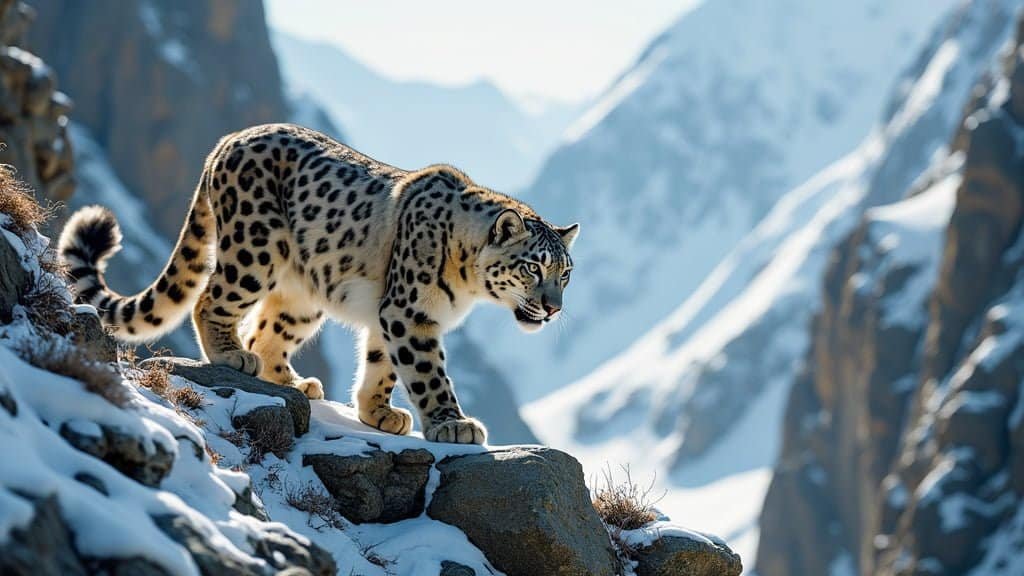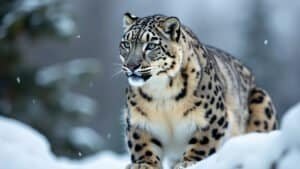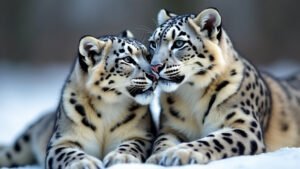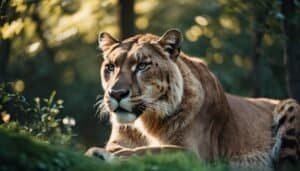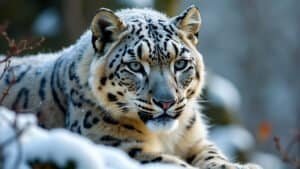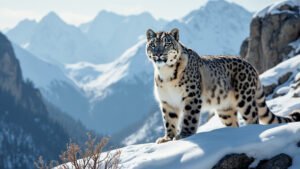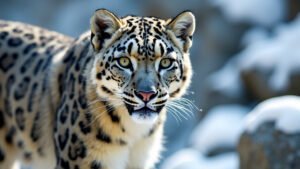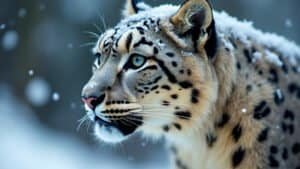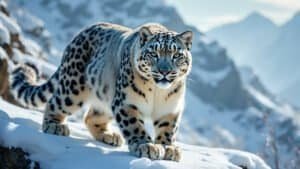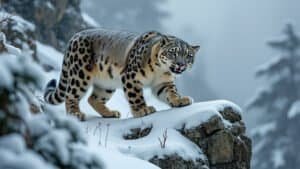Introduction
The snow leopard, an elusive predator of Central Asia’s mountainous regions, is a remarkable example of how diet can shape an animal’s genetic makeup
This article explores the intricate relationship between the snow leopard’s dietary habits and its genetic evolution, focusing on how the scarcity of prey and harsh environmental conditions have driven key adaptations
We will examine the primary components of the snow leopard’s diet, the genetic traits that have evolved in response to these dietary needs, and the role of environmental factors in this evolutionary process. Additionally, we’ll draw comparisons with other apex predators to understand the unique evolutionary path of the snow leopard
The Snow Leopard’s Diet: What Do They Eat?
Snow leopards, known scientifically as Panthera uncia, inhabit some of the harshest environments on Earth, primarily the mountainous regions of Central Asia, including the Himalayas, the Tibetan Plateau, and the Altai Mountains
Their diet is a reflection of the sparse and challenging ecosystems in which they live. Understanding what snow leopards eat is crucial to grasping how their diet has influenced their genetic evolution. Their prey not only provides the necessary nutrients for survival but also exerts selective pressures that have shaped their physical and genetic characteristics over time
Prey in the Snow Leopard’s Habitat
The snow leopard’s habitat spans vast and varied terrains, but it is generally characterized by rugged mountains, steep cliffs, and high altitudes, often above 9,800 feet (3,000 meters)
The harsh environment limits the availability of prey, which largely consists of herbivores adapted to these regions. The primary prey species for snow leopards include blue sheep (Pseudois nayaur), also known as bharal, and the Siberian ibex (Capra sibirica). These animals are well-adapted to the steep, rocky terrain, making them challenging yet vital targets for the snow leopard
In addition to these primary prey, snow leopards also hunt smaller mammals like marmots, pikas, and hares, particularly in regions where larger prey is scarce
Studies have shown that snow leopards may even prey on domesticated animals, such as yaks, sheep, and goats, when wild prey is not readily available. This occasional shift to livestock can lead to conflict with human populations, further complicating the conservation efforts for this endangered species
The snow leopard’s diet is thus a direct product of its environment. The necessity to hunt large, agile herbivores in difficult terrain has influenced not only the snow leopard’s hunting strategies but also its physical and genetic traits
Hunting Techniques and Dietary Preferences
Snow leopards are solitary predators, relying on stealth and strength to bring down their prey. They typically hunt at dawn and dusk, using the cover of darkness and their natural camouflage to get close to their targets
The leopard’s thick, smoky-gray fur with black rosettes and spots provides excellent camouflage against the rocky, snow-dusted landscape. This camouflage is critical for sneaking up on prey in open areas where there is little cover
Once within striking distance, the snow leopard pounces, aiming to catch its prey by surprise. The success of a hunt often depends on the element of surprise, as these predators are not as fast as some of their feline relatives, such as cheetahs
Instead, they rely on their powerful build to overpower prey once they make contact. Their diet is predominantly carnivorous, with a strong preference for large ungulates, but it can vary significantly based on availability. During lean periods, snow leopards have been known to scavenge or hunt smaller animals to sustain themselves
Seasonal variations also play a role in the snow leopard’s diet. In winter, when harsh conditions make hunting more difficult and prey more scarce, snow leopards may descend to lower altitudes in search of food. This seasonal migration often brings them closer to human settlements, increasing the likelihood of predation on livestock
Seasonal Variations in Diet
The seasonal availability of prey has a significant impact on the snow leopard’s diet. During the summer months, when prey like blue sheep and ibex are more abundant at higher altitudes, snow leopards remain in the upper reaches of their range
These herbivores are crucial for sustaining the snow leopard population, providing the high-energy diet necessary for survival in such a challenging environment
However, as winter sets in, the dynamics change. The snow and cold drive many prey species to lower altitudes in search of food, and the snow leopards follow. During these times, snow leopards may target alternative prey, including smaller mammals and occasionally livestock
This seasonal shift in diet not only reflects the snow leopard’s adaptability but also underscores the challenges it faces in maintaining a stable food supply throughout the year
The dietary habits of snow leopards are not merely a reflection of what is available; they are a key driver of the species’ evolutionary path. The need to hunt large, agile prey in difficult terrain has led to the development of specific physical traits, such as powerful limbs and a highly efficient respiratory system, which are crucial for chasing and capturing prey at high altitudes
These adaptations are also mirrored in the snow leopard’s genetic makeup, with certain genes playing a role in muscle development, oxygen utilization, and metabolic efficiency
This intricate relationship between diet and evolution highlights the snow leopard’s incredible ability to thrive in one of the world’s most challenging environments. However, it also makes them vulnerable to changes in their ecosystem, whether due to climate change, human encroachment, or fluctuations in prey populations
Genetic Adaptations Arising from Dietary Habits
The snow leopard’s diet has not only shaped its behavior and physical traits but has also driven significant genetic adaptations that allow it to thrive in its extreme environment
These genetic changes are critical to understanding how the species has evolved to become a top predator in the high-altitude regions of Central Asia. The selective pressures exerted by the snow leopard’s specialized diet have led to the development of unique genetic traits that support its survival and reproductive success
Metabolic Adjustments to a Carnivorous Diet
Snow leopards are obligate carnivores, meaning their diet consists almost exclusively of meat. This reliance on a high-protein, high-fat diet has driven specific metabolic adaptations that enable the efficient processing of animal-based nutrients
One of the most notable genetic adaptations in snow leopards is the evolution of genes associated with fat metabolism. Research has identified alterations in genes such as PPARA (Peroxisome Proliferator-Activated Receptor Alpha) and ADIPOQ (Adiponectin), which play crucial roles in lipid metabolism and energy homeostasis
These genetic variations allow snow leopards to efficiently break down and utilize the energy from fat, which is abundant in their prey but essential for surviving in cold, high-altitude environments. The ability to metabolize fat effectively is particularly important during winter months when food is scarce, and the need for energy conservation is paramount
Additionally, the snow leopard’s diet requires adaptations to handle large amounts of protein, and genetic studies have shown enhanced expression of enzymes involved in protein digestion and nitrogen metabolism. This ensures that the snow leopard can extract the maximum nutritional value from its prey, even when it catches only a few large animals over extended periods
Another critical aspect of the snow leopard’s metabolism is its ability to thrive at high altitudes, where oxygen levels are significantly lower than at sea level
Genetic studies have revealed adaptations in genes related to oxygen transport and utilization, such as EPAS1 (Endothelial PAS Domain Protein 1), which is also associated with high-altitude adaptation in other mammals, including humans and Tibetan yaks. These adaptations help snow leopards maintain their energy levels during intense physical activity, such as hunting, in oxygen-poor environments
Evolution of Hunting-Related Physical Traits
The physical traits of snow leopards are perfectly suited for their role as apex predators in a challenging environment. Over time, these traits have been honed by natural selection, driven largely by the demands of their diet
One of the most distinctive features of the snow leopard is its powerful hind legs, which enable it to leap great distances—up to 50 feet in a single bound. This remarkable ability is essential for ambushing prey in steep, mountainous terrain
Genetic research has identified several genes that contribute to the development and maintenance of these muscular traits. For instance, variations in the ACTN3 gene, often referred to as the “speed gene,” are associated with fast-twitch muscle fibers, which are critical for rapid, explosive movements such as those needed to pounce on prey
Additionally, genes involved in bone density and muscle attachment, such as COL1A1 (Collagen Type I Alpha 1 Chain), have also been shown to exhibit unique variations in snow leopards, reflecting the physical demands of their hunting style
Moreover, the snow leopard’s thick, well-insulated fur and its large nasal cavities are adaptations to its cold environment and high-altitude lifestyle. The thick fur provides insulation against freezing temperatures, while the large nasal passages help warm the cold air before it reaches the lungs
These physical traits are underpinned by genetic adaptations in fur density and thermoregulation genes, ensuring that the snow leopard can maintain its core body temperature even in extreme conditions
Genetic Markers Linked to Dietary Specialization
The genetic adaptations that allow snow leopards to thrive on their specific diet are not just limited to metabolic processes and physical traits; they also include markers of dietary specialization. These markers help researchers understand how snow leopards have diverged from other big cats in response to their unique dietary needs
For instance, studies on the snow leopard’s genome have revealed unique variations in the MC1R (Melanocortin 1 Receptor) gene, which is involved in the regulation of skin and fur color
These variations are thought to be linked to the need for effective camouflage in the snowy and rocky environments of the snow leopard’s habitat, aiding in hunting success by allowing the predator to remain unseen by its prey
Another important genetic marker is found in the TAS2R (Taste Receptor, Type 2) gene family, which influences taste perception. In carnivores like snow leopards, certain bitter taste receptors have been lost or altered, reflecting a diet that is exclusively meat-based and devoid of the plant toxins that these receptors typically detect
This loss of function in taste receptors is a common evolutionary trait among obligate carnivores and highlights the snow leopard’s dietary specialization
Furthermore, genetic studies have identified unique variants in genes related to the olfactory system, which are critical for a predator that relies heavily on scent to locate prey in vast, open landscapes. The evolution of these genes suggests a heightened ability to detect prey from long distances, an essential adaptation for survival in environments where prey is widely dispersed
The snow leopard’s genetic adaptations to its diet are a testament to the powerful role that diet plays in shaping the evolution of species. By analyzing these genetic markers, scientists can gain deeper insights into how the snow leopard has evolved to become one of the most efficient predators in its environment
These findings also underscore the importance of preserving the snow leopard’s natural habitat and prey base, as any significant changes could disrupt the delicate balance that has driven its evolutionary success
Impact of Environmental Factors on Diet and Evolution
The environment in which the snow leopard lives is one of the most challenging on Earth. The harsh, mountainous terrain, extreme temperatures, and limited prey availability have not only shaped the snow leopard’s diet but have also driven significant evolutionary changes
Understanding the impact of these environmental factors is key to comprehending how the snow leopard has adapted to survive in such an inhospitable environment
Prey Availability and Genetic Diversity
Prey availability is perhaps the most crucial environmental factor influencing the snow leopard’s diet and genetic evolution. Snow leopards are primarily found in regions where large herbivores like blue sheep and ibex are present
However, the density of these prey species can vary significantly depending on local environmental conditions, such as the availability of vegetation, seasonal changes, and human interference
The scarcity of prey in these regions has forced snow leopards to develop a highly opportunistic hunting strategy. Genetic studies have shown that snow leopards have a relatively low level of genetic diversity compared to other big cats, which is likely a consequence of their isolated populations and the limited availability of prey
This reduced genetic diversity can make the species more vulnerable to environmental changes, such as fluctuations in prey populations or habitat loss, as it limits their ability to adapt to new conditions
However, this low genetic diversity is also indicative of a high degree of specialization. The snow leopard’s genome contains several adaptations that are specifically tailored to the unique challenges of its environment
For instance, variations in genes related to energy metabolism and muscle function are thought to be adaptations to the energy-intensive lifestyle of hunting large, elusive prey in rugged terrain
Climate Change and Shifting Dietary Needs
Climate change is increasingly affecting the snow leopard’s habitat, leading to shifts in the availability and distribution of prey species. As temperatures rise and precipitation patterns change, the alpine ecosystems that snow leopards depend on are being altered
This can lead to a decline in the populations of key prey species like blue sheep and ibex, forcing snow leopards to adapt their diet or risk starvation
One of the most significant impacts of climate change on the snow leopard’s diet is the potential for range shifts in both predators and prey. As temperatures warm, prey species may move to higher altitudes in search of cooler habitats, which could in turn push snow leopards into new areas
This shift could lead to increased competition with other predators, such as wolves, or a greater reliance on smaller or less nutritious prey
The genetic consequences of these dietary changes are not yet fully understood, but they could potentially lead to further evolutionary adaptations as snow leopards adjust to new prey species or hunting strategies
Additionally, climate change may exacerbate the genetic bottleneck effect by further isolating snow leopard populations, reducing gene flow between groups, and limiting the potential for genetic diversity
Geographic Isolation and Its Genetic Consequences
Geographic isolation has played a significant role in the evolution of the snow leopard. The rugged, mountainous terrain of Central Asia naturally segments snow leopard populations, leading to a high degree of genetic isolation
This isolation has resulted in distinct genetic lineages within the species, each adapted to the specific conditions of their local environment
The genetic isolation of snow leopard populations is both a strength and a vulnerability. On one hand, it has allowed for the development of specialized adaptations that are finely tuned to local conditions
For example, snow leopards in different regions may exhibit slight variations in body size, fur density, and hunting behaviors, all of which are influenced by the specific environmental challenges they face
On the other hand, geographic isolation can also limit the potential for genetic diversity, as isolated populations have fewer opportunities to interbreed with other groups. This can increase the risk of inbreeding, which can lead to a decrease in overall fitness and a greater susceptibility to diseases or environmental changes
Conservation efforts must therefore focus on maintaining habitat connectivity to allow for gene flow between populations, thereby preserving the genetic diversity that is crucial for the long-term survival of the species
The impact of environmental factors on the snow leopard’s diet and genetic evolution is a complex interplay of adaptation and vulnerability. While the species has evolved to thrive in some of the most extreme environments on Earth, it remains highly sensitive to changes in its habitat
The ongoing effects of climate change, habitat fragmentation, and prey depletion pose significant challenges to the future of the snow leopard, making it essential to understand and protect the environmental conditions that have shaped this iconic predator
Comparative Evolution: Snow Leopards and Other Apex Predators
The snow leopard’s evolution is a fascinating study in how environmental pressures shape the development of species
By comparing the genetic and physical adaptations of snow leopards to those of other apex predators, such as tigers, lions, and wolves, we can gain insights into the unique evolutionary path taken by these elusive cats
This comparative approach also highlights the commonalities and differences in how various predators have adapted to their specific ecological niches
Evolutionary Parallels with Tigers and Lions
Snow leopards, tigers, and lions all belong to the genus Panthera, making them close relatives with a shared evolutionary history. Despite their shared lineage, each species has evolved distinct traits that suit their respective environments
Tigers, primarily found in dense forests and grasslands, and lions, which inhabit savannas and open woodlands, have developed different hunting strategies, social structures, and physical adaptations compared to snow leopards
One of the most notable differences is in social behavior. Lions are the only social cats among the Panthera species, living and hunting in prides, which provides advantages in taking down large prey like buffalo
In contrast, snow leopards are solitary, a trait that is more similar to tigers. However, unlike tigers, which often rely on stealth and ambush in dense cover, snow leopards must navigate open, rocky terrain where stealth is equally crucial but more difficult to achieve due to the lack of cover. This has led to the evolution of their distinctive camouflage, which is far more specialized than that of tigers or lions
Genetically, all three species share a common ancestry, but the snow leopard has evolved several unique traits that distinguish it from its relatives. For example, the snow leopard’s adaptation to high-altitude, low-oxygen environments is a trait not seen in tigers or lions
Variations in genes like EPAS1 are critical for surviving in the snow leopard’s habitat but are not present in lowland species like lions or tigers. This genetic divergence highlights the different evolutionary pressures faced by snow leopards as opposed to their more temperate-dwelling relatives
Genetic Divergence Due to Dietary Pressures
The dietary habits of snow leopards have also driven a genetic divergence from other apex predators. While lions and tigers often prey on large herbivores, similar to snow leopards, the specific prey available to each species has led to different evolutionary outcomes
For instance, the prey species that lions and tigers hunt are often found in more abundant and predictable environments, which allows for a diet that is less varied and more consistent
In contrast, snow leopards face a more erratic and challenging food supply, hunting species like blue sheep and ibex that are not only harder to catch but also less predictable in their availability
This has led to the development of more opportunistic hunting behaviors and dietary flexibility. Genetic studies have shown that snow leopards have adapted to process a wider range of nutrients and to survive on less frequent but more calorically dense meals
This contrasts with the dietary specializations seen in lions, which often require more regular feeding to maintain energy levels, particularly in social groups where food must be shared
Additionally, the snow leopard’s high-altitude habitat requires specific adaptations for energy conservation and efficient fat metabolism, as discussed earlier. These genetic traits are less pronounced in tigers and lions, whose environments do not impose the same metabolic demands
Insights from Genomic Studies
Genomic studies have provided critical insights into how snow leopards have evolved in comparison to other apex predators
Advances in DNA sequencing have allowed scientists to identify key differences in the genomes of these species, shedding light on how environmental pressures have shaped their evolutionary paths
One of the most significant findings from genomic studies is the identification of genetic markers associated with high-altitude adaptation in snow leopards. These markers, which are largely absent in other big cats, include genes related to oxygen transport, energy metabolism, and muscle development
For instance, the snow leopard’s version of the EPAS1 gene, which plays a role in the body’s response to low oxygen levels, is distinctly different from that found in tigers or lions, reflecting the unique selective pressures of living at high altitudes
Furthermore, comparative genomic studies have revealed that snow leopards have a higher rate of positive selection in genes related to fat metabolism and energy efficiency, which are crucial for surviving in an environment where food is scarce and energy conservation is vital
These findings contrast with the genomic profiles of lions and tigers, where selection pressures have favored traits related to social hunting and dominance behaviors
Another area of interest is the evolution of the immune system in snow leopards compared to other apex predators. Due to their isolated populations and the relatively low genetic diversity, snow leopards show unique variations in immune-related genes, which may reflect their need to defend against pathogens specific to their high-altitude environments
This contrasts with the immune gene diversity seen in more widespread and genetically diverse species like lions
These genomic insights not only enhance our understanding of snow leopard evolution but also provide valuable information for conservation efforts. By identifying the genetic traits that are critical for snow leopard survival, conservationists can better understand the risks posed by habitat loss, climate change, and human encroachment
Protecting the genetic diversity of snow leopards is essential for ensuring their ability to adapt to future environmental changes
Conclusion
The snow leopard’s diet has profoundly influenced its genetic evolution, shaping the species into one of the most specialized and resilient predators in the world
From the metabolic adjustments necessary for surviving on a carnivorous diet in high-altitude environments to the physical traits that enable successful hunting in rugged terrains, the snow leopard’s genetic makeup is a testament to the power of natural selection
Environmental factors, such as prey availability and geographic isolation, have further driven the evolution of unique genetic traits that differentiate snow leopards from other apex predators. As climate change and habitat loss continue to threaten their survival, understanding these genetic adaptations is crucial for effective conservation efforts
By preserving the delicate balance between the snow leopard’s environment and its evolutionary traits, we can help ensure the future of this majestic species in its natural habitat
